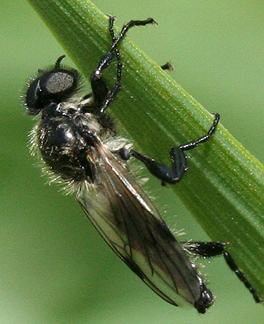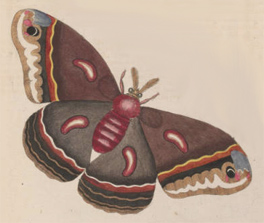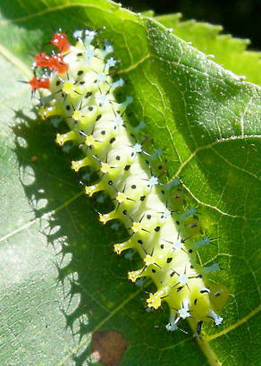At the time of the expedition, American Entomology was just emerging. There were only four notable naturalists who showed much interest in America’s insects.
Those Ignorable Insects
Most of the expedition’s journalists mentioned insects from time to time, but usually in very brief, general ways—as harbingers of spring, for example—although Captain Lewis rarely took the time to study any of them with the close attention he gave to many plants, birds, mammals, or even reptiles and fish. From Fort Mandan he sent back to President Jefferson “1 Tin box, containing insects mice &c.,”[1]Moulton, Journals, 3:330, 466. without further details, undoubtedly in the expectation that Jefferson would forward them to more qualified observers, such as Benjamin Smith Barton or Charles Willson Peale to sort them out.
Not surprisingly, Lewis occasionally paused a moment for a quick close look at a specimen, and recorded one or two details. For instance, on 11 March 1806, toward the end of the company’s Fort Clatsop residence, Lewis recorded in the month’s weather remarks a significant diurnal conjunction of winter and spring. There was an inch of snow on the ground that morning, but still there were “some insects seen in the evening in motion.” Two days later he added a little proof of hope: “saw a number of insects in motion; among others saw for the first time this spring and winter a downey black fly about the size of the common house fly.” It must have been, as editor Moulton suspected, a member of a family of “March flies” and “love bugs” called Bibionidae (bib-ee-OH-ni-die).
Thomas Jefferson, in his Notes on the State of Virginia (1787) admitted to his good friend François Barbé-Marbois (1745-1837) that “of our fish and insects there has been nothing like a full description or collection.” Barbé-Marbois was secretary of the French legation the United States from 1779 until 1785. (See The Louisiana Purchase concerning his role in that historic event.) Indeed, there were only four notable 18th century naturalists who showed much interest in America’s insects, and they were primarily horticultural entrepreneurs rather than scientists. Their business was the collection of specimens of plants, animals and birds that would satisfy the interests of European men of leisure, wealthy hobbyists fascinated with America’s natural exotica. The first of the four, in point of time, was a young Englishman named Mark Catesby (1683-1749).
Mark Catesby
Catesby’s note reads: “The Caterpillar of this Moth is inclosed by two silk bags of an oval shape; the innermost smooth within; the outside the silk lying loose; and is covered by another membrane of a thinner, smoother, and of a more compact texture, and not of so uniform a structure, as appears by the figure, though they frequently vary in size, and somewhat in form. These bags are found artfully fixed to the twigs of trees, some hanging pendant, others horizontally.This Moth is a native of Carolina, and other provinces more north.”[2]Mark Catesby, Natural History, Vol. 2 (1754), p. 86.
Larva of H. cecropia
Phalæna cecropia Linnæus (1758)[3]Paul M. Tuskes, The Wild Silk Moths of North America: A Natural History of the Saturniidae (Cornell University Press, 1996).
© 2006 Craig Biegler, BugGuide.net.
Catesby was convinced that insects probably outnumbered all other living creatures on the planet, but he could not have known that the native habitat of this particular species was limited to North America, or that it would prove to be among the largest in the Western Hemisphere. Linnæus renamed the giant moth Hyalophora cecropia (hy-uh-LO-pee-uh se-CROW-fee-uh).[4]Today it is believed that H. cecropia inhabits a region extending from the Maritime Provinces of Canada to northern Florida, and from the Atlantic Coast to the Rocky Mountains. It has been observed … Continue reading
Twenty-nine-year-old Mark Catesby sailed to Williamsburg, Virginia from London in 1712, to live with his sister, her husband the recently appointed Secretary of State for the Colony of Virginia, and their children. The move provided Mark with the opportunity to satisfy his long-held “passionate desire” to explore exotic places, so he soon set out for the wilderness of the Blue Ridge Mountains and points south, and began immediately to sketch live fish, birds, reptiles and animals, as well as freshly collected specimens of plants and flowers. “I had principally,” he wrote, “a regard to Forest-Trees and Shrubs, shewing their several Mechanical and other Uses, as in Building, Joinery , Agriculture, and others used for Food and Medicine.” He also sought out “Plants, that will bear our English Climate.” The British Isles, as well as many parts of continental Europe, were greatly in need of wood, their lands having become denuded to meet the demands for fuel and building materials. For several generations the same thing had been happening to the forests of New England and along the Atlantic Coast, which some people, including Thomas Jefferson, blamed for the perceivable warming of the climate.
The results of Catesby’s 1712-19 visit to southeastern North America gained him encouragement and financial support from several influential British gentlemen, enabling him to make a second trip in 1722. Seven years later he began publishing his life’s work, The Natural History of Carolina, Florida, and the Bahama Islands: Containing the Figures of Birds, Beasts, Fishes, Serpents, Insects, and Plants . . . . , proceeding in sections of twenty plates each until 1743, when the final two-volume work, containing 220 plates, was complete. It was the sole pre-Linnæan book on American natural history.[5]James L. Reveal, “Identification of the Plants and Animals Illustrated by Mark Catesby for his Natural History of Carolina, Florida and the Bahama Islands. Phytoneuron 2013-6: 1-55. Published … Continue reading
Thomas Jefferson is known to have owned a copy of Catsby’s opus, and it has been suggested that Meriwether Lewis might have looked into it there during his 23-month stint as the President’s aide-de-camp.[6]Paul Russell Cutright, Lewis & Clark: Pioneering Naturalists (Lincoln: University of Nebraska Press, 1969), 31. We have no documentary proof whether he did or not, but the young captain worked very hard at his job, and if he had time for reading it would have been, at the President’s urging, of his copy of Alexander Mackenzie‘s triumphant Voyages from Montreal, published in 1801, recounting in detail his crossing of North America through Canada in 1793.
Peter Kalm
Peter Kalm, a Finnish botanist, born in Sweden, was next in line. He was counted among a group of students of Carl Linnaeus who were known as his “apostles.”[7]Apostle is a Greek verb meaning “to send”; as a noun it means “messenger.” It was Linnæus, in fact, who arranged with the Royal Swedish Academy of Sciences for Kalm to sail to the American Colonies in 1748 to search for native plants and seeds that might profitably be grown in Sweden for the benefit of the economy. One tree that was especially desired was the red mulberry (Moris rubra), a native of America that was known to be an attractive host tree to silk moths. Altogether, 90 specimens collected by Kalm in America were included by Linnæus in the tenth edition of his Systema Naturae of 1758.
During his fourteen-month American sojourn (August 1748-October 1749) that took him from Philadelphia, north to Montreal and Quebec, and west to Niagara Falls. In Philadelphia, he was welcomed and advised by Benjamin Franklin and naturalist John Bartram (the father of William), who answered his questions and freely offered a great deal more information about American flora and fauna. Kalm became best known for his scientific paper, published in Sweden in 1756, on the 13- to 17-year periodical cicada, which spends uninterrupted years of underground survival, nourished on fluids from the xylem in the roots of trees and shrubs.[8]“Pehr Kalm’s Description of the Periodical Cicada, Magicicada Septendecim L.” in Ohio Journal of Science (Ohio Academy of Science 1953), 53:3. The cicada is often called a locust, but that’s a misnomer that properly denotes a certain breed of grasshopper. In the U.S., the Rocky Mountain locust, Melanoplus spretus, became extinct after the fragile soils of many Rocky Mountain valleys were subject to intensive agricultural use during the growth of mining communities. Its role has been replaced by the desert locust (Schistocerca gregaria), which is found in various parts of North America.[9]Jeffrey A. Lockwood, Locust: the Devastating Rise and Mysterious Disappearance of the Insect that Shaped the American Frontier (New York: Basic Books, 2005). Linnaeus, Kalm’s mentor, named it Magicicada septendecem (majih-sih-KAY-duh sep-ten-DEE-chem), and published its name and description in the 10th edition (1758) of his Systema Naturae.
William Bartram
William Bartram
by Charles Willson Peale, 1808
Independence National Historical Park, Philadelphia. Oil on paper.
The sprig of flowers tucked into Bartram’s waistcoat is the sweetly fragrant Jasminum grandiflorum (L.), which has been cultivated for many centuries in Asia, as well as in Europe, where it is still known as Poet’s Jasmine. It was introduced into the US, but is now cultivated only in Alachua County, Florida.[10]Atlas of Florida Vascular Plants, florida.plantatlas.usf.edu, accessed 17 December 2013.
William Bartram (1739-1823) was born and raised in a Quaker family in Kingsessing, Pennsylvania (now a neighborhood in Southwest Philadelphia west of the Schuylkill River). In 1778, with financial support from the English Quaker physician, philanthropist and plant collector John Fothergill (1712–1780), he began a four-year-long stroll through the colonies of North and South Carolina, Georgia, East & West Florida, and the homelands of the Cherokee, Creek, and Choctaw Indians, a region that he saw as an ideal, peaceful paradise. Bartram began the Introduction to his travel diary with the advice to that “the attention of a traveller should be particularly turned in the first place, to the various works of Nature,” such as “the rustling clouds” of insects—”the Ephemera.” In phrases vibrant with the emotional spirit of romanticism, he described the brooding swarms of insects of unknown species:
How awful the procession! innumerable millions of winged beings, voluntarily verging on to destruction, to the brink of the grave, where they behold bands of their enemies with wide open jaws, ready to receive them. But as if insensible of their danger, gay and tranquil each meets his beloved mate in the still air, inimitably bedecked in their new nuptial robes. What eye can trace them, in their varied wanton amorous chaces [chases], bounding and fluttering on the odoriferous air! With what peace, love, and joy, do they end the last moments of their existence?”[11]William Bargram, Travels of William Bargram (Dublin, 1791, 1793), 80.
It is small wonder that Bartram’s journal was read with interest and admiration by the Lake Country poets, who set the English Romantic Movement in motion with lyrics such as William Wordsworth’s “A Morning Exercise,” Samuel Taylor Coleridge’s “Lines to a Beautiful Spring in a Village,” or Robert Southey’s “Sonnet 10.” Wordsworth was born in 1770, as was William Clark; Coleridge was born two years later, and Southey in 1774, the same year as Meriwether Lewis. But that they happened to belong to exactly the same generation is not to imply that Lewis was therefore a Romanticist. He was, as Clay Jenkinson has pointed out, “a scientist, a rationalist, a deist, and a Jeffersonian.”[12]Clay Jenkinson, The Character of Meriwether Lewis, Explorer in the Wilderness (Washburn, North Dakota: Dakota Institute Press of the Lewis & Clark Fort Mandan Foundation, 2011), 336. Those four characteristics were sufficient to dissociate him from the literary styles of the Lake Country poets, although he was capable of crafting phrases close enough to theirs to prove that as a travel writer he could at least have transcended the cool objectivity of a Mackenzie.
Reverend Frederick Melsheimer
The first and, for the next ten years the only, extensive study of insects in America was A Catalog of Insects of Pennsylvania, containing 1,363 species of beetles collected by Frederick Melsheimer (1782-1873), a Lutheran minister, and published in Hanover, New Hampshire, in 1806. “To the best of my Knowledge,” wrote the Reverend Melsheimer in his Introduction, “I have but few Predecessors in the United States in this Undertaking.” However, his work was difficult for most farmers and gardeners to use because he named and described genera and species according to the system devised by the Danish entomologist Johann Christian Fabricius (1745-1808), which was based on the structures of mouth-parts, rather than Linnæus’s “sexual system” built on the reproductive functions of flowers and seeds, obviously less suitable to the study of mammals and insects. Nevertheless, Thomas Say (1787-1834), who richly deserved his own growing reputation as his generation’s premiere authority on insects in America, charitably acknowledged the industrious, perhaps compulsive Melsheimer as “the parent of entomology in this country.”
Notes
| ↑1 | Moulton, Journals, 3:330, 466. |
|---|---|
| ↑2 | Mark Catesby, Natural History, Vol. 2 (1754), p. 86. |
| ↑3 | Paul M. Tuskes, The Wild Silk Moths of North America: A Natural History of the Saturniidae (Cornell University Press, 1996). |
| ↑4 | Today it is believed that H. cecropia inhabits a region extending from the Maritime Provinces of Canada to northern Florida, and from the Atlantic Coast to the Rocky Mountains. It has been observed throughout the Great Plains—bounded on the east by the Mississippi River and on the west by the Rocky Mountains, from north central Canada to the Rio Grande River—but whether those sightings represent the species’ prehistoric range, or a consequence of the westward expansion of agriculture in the mid- to late-19th century, is uncertain. |
| ↑5 | James L. Reveal, “Identification of the Plants and Animals Illustrated by Mark Catesby for his Natural History of Carolina, Florida and the Bahama Islands. Phytoneuron 2013-6: 1-55. Published 28 January 2013. |
| ↑6 | Paul Russell Cutright, Lewis & Clark: Pioneering Naturalists (Lincoln: University of Nebraska Press, 1969), 31. |
| ↑7 | Apostle is a Greek verb meaning “to send”; as a noun it means “messenger.” |
| ↑8 | “Pehr Kalm’s Description of the Periodical Cicada, Magicicada Septendecim L.” in Ohio Journal of Science (Ohio Academy of Science 1953), 53:3. |
| ↑9 | Jeffrey A. Lockwood, Locust: the Devastating Rise and Mysterious Disappearance of the Insect that Shaped the American Frontier (New York: Basic Books, 2005). |
| ↑10 | Atlas of Florida Vascular Plants, florida.plantatlas.usf.edu, accessed 17 December 2013. |
| ↑11 | William Bargram, Travels of William Bargram (Dublin, 1791, 1793), 80. |
| ↑12 | Clay Jenkinson, The Character of Meriwether Lewis, Explorer in the Wilderness (Washburn, North Dakota: Dakota Institute Press of the Lewis & Clark Fort Mandan Foundation, 2011), 336. |
Experience the Lewis and Clark Trail
The Lewis and Clark Trail Experience—our sister site at lewisandclark.travel—connects the world to people and places on the Lewis and Clark Trail.
Discover More
- The Lewis and Clark Expedition: Day by Day by Gary E. Moulton (University of Nebraska Press, 2018). The story in prose, 14 May 1804–23 September 1806.
- The Lewis and Clark Journals: An American Epic of Discovery (abridged) by Gary E. Moulton (University of Nebraska Press, 2003). Selected journal excerpts, 14 May 1804–23 September 1806.
- The Lewis and Clark Journals. by Gary E. Moulton (University of Nebraska Press, 1983–2001). The complete story in 13 volumes.





